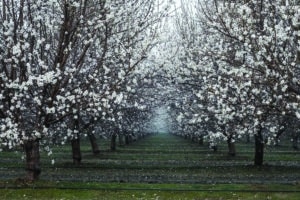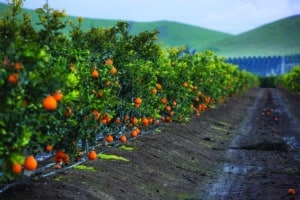By Abe Isaak, Agronomist
 Every year, from the beginning of almond harvest through post-harvest applications, the signs of damage from sodium in crops is evident in many orchards; leaf edges showing burn, leaf drop and even serious defoliation. This damage has a direct affect on yield for the following crop year. The tree will show indications of damage earlier in the spring in the subsequent year, but you need to begin mediating the symptoms of sodium damage before you see these signs. Once the damage becomes visible, you are on the defensive and there are less options at your disposal. We’ve updated this blog post in 2023 to give you additional information.
Every year, from the beginning of almond harvest through post-harvest applications, the signs of damage from sodium in crops is evident in many orchards; leaf edges showing burn, leaf drop and even serious defoliation. This damage has a direct affect on yield for the following crop year. The tree will show indications of damage earlier in the spring in the subsequent year, but you need to begin mediating the symptoms of sodium damage before you see these signs. Once the damage becomes visible, you are on the defensive and there are less options at your disposal. We’ve updated this blog post in 2023 to give you additional information.
Risk and Mitigation of Damage from Sodium in Crops
With little rainfall this winter, the soil has had little opportunity to leach out sodium with clean rain water and we haven’t gotten the deep moisture in the soil that the plant needs. This means the top foot of soil has a higher concentration of sodium. The risk of sodium burn begins when the weather turns hot, usually in May, and worsens as the summer months usher in 100+° temperatures in the central valley. Plants will go into stress starting at 85 degrees.
Calcium and Sodium Damage in Crops
Calcium is often applied to the soil in either the form of gypsum or lime in an effort to improve soil structure and improve water and air movement. Also, discuss your soil analysis with a trusted advisor to determine the rate and product you should use to amend the soil. This effort to improve water movement in the soil can, in part, help reduce the sodium concentration in the top layer of soil, as this nutrient is easily leached from the root zone. Many growers stop here and hope this is enough to stop sodium damage to the plant. This can be a good start, but many times it isn’t enough. Calcium is a tool in the toolbox but it isn’t the total answer by itself. There is more than can be done.
Potassium and Sodium Damage
Potassium (K) is vital for many processes in the plant. It regulates the stomata opening and closing, and plant respiration. These processes help regulate temperature. As the weather gets warmer, the plant will pull potassium from the soil. The problem is that sodium and potassium have similar chemical properties. Because it is generally more available for the plant to use, sodium will be taken into the plant before the needed potassium. Chloride presents a similar problem, and it will also be grabbed from the soil, as well.
The result of this nutrient competition is that within a few days of sodium and/or chloride uptake, the plant will start to lose its vigor, the leaves will start to droop and show signs of wilt. If left unchecked, the edge of the leaves will show signs of burn. Severe cases will experience defoliation.
 How Does Potassium Win?
How Does Potassium Win?
Obviously, we want the plant to take up potassium instead. Using a soluble form of potassium is very important to ensuring uptake, as is soil application of the potassium fertilizer. However, many times central California soils have a high pH and that limits the availability of potassium to the plant.
Another way to improve potassium levels in the plant is with foliar applications. Ideally, this begins in the fall with a good post-harvest application, followed by several more during the spring. Early season applications should begin at bloom and can be added to passes you make through the field for other applications such as fungicides and pesticides (always follow label instructions and perform a jar test when applying any agricultural input product).
Know Your Needs
How do you know if you need to add potassium to your crop nutrition program and how much should you apply? This is where tissue testing is very important. Review your previous years’ tissue samples to help recognize any trends. This spring, when the leaves are fully developed, take a tissue test and check your numbers. Ideally 2.8% to 3.1% is where that number should be to help deal with sodium in the plant and to provide for crop needs. A good rule of thumb is to have potassium at 80% of nitrogen. As an example, if nitrogen is at 3.5%, you want potassium at 2.8%. A hungry plant will not care what it drinks to meet its need; a plant that is not starving will be much more selective in what it takes in.
One key point to remember: tissue tests tell us where we have been with our nutrition programs, not necessarily where we are going. If your results come back and things look good and the numbers are where you want them to be, don’t let up. Stay on top of this potential problem.
If you have any questions about tissue testing or developing a crop nutrition program for your operation, contact your AgroLiquid representative or visit us at agroliquid.com.


 How Does Potassium Win?
How Does Potassium Win?